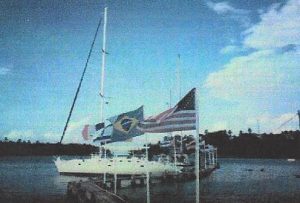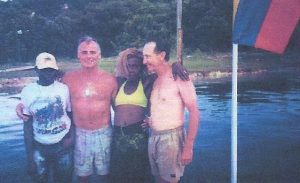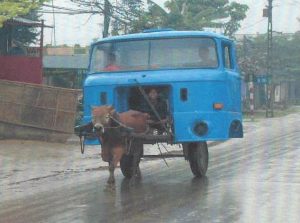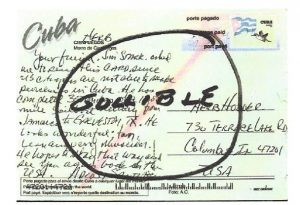In May 2001, a few months after I retired, I signed on as crew for a three-week sailboat delivery from the British Virgin Islands (BVI), across the Gulf of Mexico to Texas. Such opportunities are available by doing searches on the internet. My wife, Michele, and I had discussed buying a blue-water sailboat and doing some serious off-shore sailing. We own a twenty-four-foot sailboat and have chartered sailboats in the BVI for several days at a time, so we considered ourselves experienced sailors. What I wasn’t familiar with were procedures for entering foreign ports and the clearing-in and out process. The sailboat being delivered was a fifty-foot sloop, named “Painkiller” (a popular Caribbean rum drink) sold out of a charter fleet in Tortola in BVI. Once the boat arrived in Texas, it would be put on a truck and taken to its new owner in California.

It was 700 miles across the Gulf requiring five days of around the clock, 24-hour sailing. However, the passage from Jamaica to the Gulf would give us the opportunity to sail along the southern coast of Cuba, spending nights at anchor.

Visiting Cuba was not prohibited, however, according to the Trading with the Enemy Act issued by the U.S. government in 1963, it is illegal for a U.S. citizen to engage in economic transactions with Cuba. The regulation effectively prohibited spending money in Cuba. So, how could you go there and not spend money? Citizens were going to Cuba, either flying in from Canada or arriving by boat. Cuba welcomed tourists and when returning to the U.S., tourists were apparently just mum about any purchases.
We were a crew of four, Captain Bob, and two recently divorced bachelors, Mark and Kevin. Mark had crewed on a delivery before, but Kevin was rather inexperienced. I was serious about the educational opportunity this delivery offered, but Mark and Kevin, not so much. They viewed the trip more as a lark.

(L to R) Kevin and Mark—the white guys
At the midpoint of our delivery, we planned to spend two nights in Cienfeugos, Cuba, giving us a day to get off the boat and relax. Cienfeugos is Cuba’s third largest city with a population of 165,000 citizens. The Captain planned to do some sightseeing. Mark and Kevin were looking forward to exploring the Cuban social scene and perhaps hooking up with some Chicas (young ladies). As for myself, after spending a number of days on a fifty-foot boat in close quarters with three crewmates, I was just looking for an opportunity to be alone. Therefore, I volunteered to do the shopping and to provision the boat for the second half of our delivery. My offer was readily accepted.
Departing the marina to go grocery shopping, I was immediately aware of Cuban soldiers with machine guns slung over their shoulders guarding the waterfront. Cubans escaping the Communist island by taking boats to the U.S. was prohibited.
The street outside the marina was strangely quiet. Large homes had been abandoned and their windows boarded up. I learned later, when Fidel Castro’s revolution was anticipated, many of the wealthy citizens left their homes and escaped to U.S., Spain, and other countries. A horse drawn trolley appeared picking up riders. The trolley was free for Cubans. Several 1950 and 1960 U.S. automobiles were seen parked in courtyards.

Cuban SUV
I didn’t know where I was going other than my need to first change my U.S. dollars into pesos and then to find a food market. A stop at a fruit stand seeking information was not helpful other than the proprietor pointed to a small gathering of men on the opposite street corner.
Approaching the group and asking, “English? English?” brought forth a man with marginal language skills. I explained my dollar exchange need and my interest in finding a grocery. He raised a finger of understanding and made a phone call. A short five minutes later a late model foreign car arrived, driven by a nice looking man in his early 30’s by the name of Miguel. He spoke no English but seemed to understand my mission.
Off we went, arriving at a bank-like building, called a Money Exchange, but it had hordes of locals clustered around its entry. Oh, no. This would take forever to get inside. “No,” Miguel signed, “Go right in.” The people outside just wanted to buy my U.S. dollars first.
Inside, I plunked down $200 dollars to be exchanged for pesos. The clerk punched buttons on a cash machine and I watched in disbelief as a two inch stack of money spit out into a tray. “Oh, no. I won’t be able to get that pile in my pocket.”
“Senior, that’s just $100 dollars of it.”
“Larger bills, larger bills,” I pleaded.
Finally, I left with just a one-inch roll of pesos stuffed in my pockets.
Miguel was very friendly. On our way to the grocery, through sign language, I learned he was married and had a two-year-old son. I explained that my three sons were grown men. He understood, laughed, and gave me a thumbs up.
Miguel accompanied me into the grocery. I was surprised at how well stocked the shelves were. That was contrary to the shortages I understood to be prevalent in Cuba. I was also surprised to see few local citizens in the store, most seemed to be foreign tourists. I quickly filled the cart with items from my shopping list. If I couldn’t find something, I’d act it out for Miguel, like smearing jam on bread or peeling a banana. Miguel understood immediately and would run off and return beaming with the desired items. At the cash register we both placed the purchases on the conveyor belt.
Miquel spoke with the cashier asking for the tally then slapped his forehead in disbelief. “What is it?” I asked. “This is a dollar store,” Miquel was told, established by Castro to attract tourist and they only accept U.S. dollars. Oh no! I also slapped my forehead.
Fortunately, I had a $100 bill tucked in my wallet for emergencies and was able to pay for the groceries. But now we needed to return to the money exchange and change those pesos back into dollars. En route I wanted to buy some postcards and asked two British tourists who spoke Spanish to explain that to Miguel. He understood, “Si, si.” And took me to a shop where I bought 27 picture post cards.
The return to the money exchange was another forehead slapping experience. You were not permitted to exchange pesos back into dollars. So now I was the proud possessor of a 4,440 peso souvenir of Cuba.
Driving back to the marina, I wondered how much to pay Miguel for his services. Remembering my arrival at the start of this sailboat adventure, I had paid $30 for the taxi ride from the airport to the harbor. Therefore, after unloading the groceries, I handed Miguel a slip of paper on which I had written $40 = 880 Pesos and handed Miguel the money. He seemed overwhelmed. Shaking my hand, he kept repeating, “Mi amigo, mi amigo”. Later, I learned Cuban doctors are paid the equivalent of $25 per week, so perhaps I over-tipped Miguel, but he had become a highlight of my Cuban visit.
Back on the boat, I spent the afternoon writing my 27 postcards. Knowing U.S. citizens were not allowed to spend money in Cuba, I wrote the cards as someone named “Santiago” which is “James” in Spanish, saying in part, “I met your friend, Jim Stark, in Cuba. He is on an extended sailboat delivery from the BVI to Texas. He looks tan and very muscular. He looks forward to seeing back in the states. Adios, Santiago.”
While writing my cards, the Captain returned from his sightseeing. I told him about the money exchange problem. “You realize,” he said, “you will never be able to exchange those pesos back in the states. Let me have them and I’ll see what I can do.” He then left the boat.
Weeks later when back in the states, I learned that when my friends received the cards, they got the joke and understood it was me writing, except for my friend Herb. When I saw Herb, he told me about the strange card he had received. I just started laughing which reveled who the real sender was. Herb had saved the card and later gave it to me with the word “Gullible” written across it.

Having finished writing the cards, I left the boat hoping to find a hotel that might mail the cards for me. Then, there in front of the marina, up pulled Miguel with his lovely young wife in the car. He wanted his spouse to meet his new American friend. When Miguel saw the postcards in my hand he whisked me into his car and off we went to the post office.
Returning to the marina, I wanted to show Miguel and his wife our boat, however the armed Cuban soldiers would not allow it. Finally, after begging and pleading, one of the ranking guards said, “Okay, but only for five minutes.”
That gave me enough time to show the two the boat, and give them a beer. During our brief visit, the captain returned with good news. After visiting three different black-market sources, was able to convert my pesos back into dollars less a small service fee.
Saying goodbye to Miguel I felt he had become a true friend. My biggest regret of the entire experience was I had not taken a photo on Miguel. He gave me a card with his address and later I mailed him some photos of me and the boat and enclosed some remaining pesos. I never heard back from Miguel, but neither was my mail returned, so I’m hopeful mi amigo received it.
I liked the pic of the Cuban SUV! Interesting! Even tho’ this was 20 yrs. ago in Cuba, still interesting culture and information. Thanks for the travelogue. Keep writing!
Katherine, thank you for your note above and the reference to the Rocas.
Your stories and adventures are amazing!! I have never been to Cuba but I feel I have a lot of insight into the country because of the Roca boys. Of course, Ruben is my brother in law. Many friends who have visited have enjoyed the time there. I believe the main area they visit is Havana. Keep sending off your interesting stories.
Another good story. Thank you.